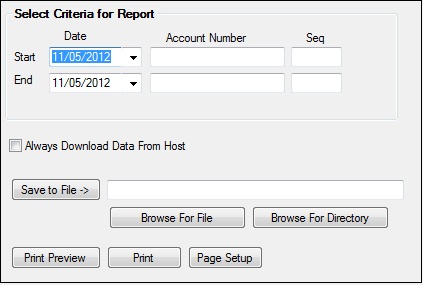Navigation: Print Reports >
You must use the Print IAT Detail screen under GOLD Services > GOLD ExceptionManager > Print Reports to print a report of all exception items from a day (or range of days) originating from International ACH transactions (IAT). This report enables you to audit and perform OFAC checks on IAT data when you are handling the items in GEM. Only the items that are in GEM will be on the report.
IAT exceptions show in GEM with "IAT" in the Comments field. If "IAT-OFAC" shows in this field, it means that the transaction passed OFAC screening and rejected to GEM for holds or balance issues. If "OFAC" is not shown in the field, the item is an OFAC suspect. You need to use this report for transactions as well as for other holds and balance issues to audit them.
Exception items are stored on the system for two years and then deleted. However, you can keep a hard copy record of the activity by printing this report.
You can also view the IAT Detail report in GOLDView. For more information, see FPSDR217. The OFAC Report is FPSDR338.
To print the regular exception items report, use the Print Reports > Exceptions screen.
To print the IAT report:
| 1. | Access the IAT Detail screen under GOLD Services > GOLD ExceptionManager > Print Reports in the tree navigation. |
See the following example:

| 2. | In the Select Criteria for Report field group, enter the Start and End Date range you want printed. Note: You can only handle items for one day, so you may also want to print only one day at a time. If you choose to print for a range of dates, the system will display a message asking you if you are sure you want to print the report. |
| 3. | If you want to print a report for only a certain account or range of accounts, enter the Start and End Account Number range for the report you want printed. |
| 4. | If you want to print a report for only a specific sequence number or range of sequence numbers, enter the Start and End Seq number range of the exception items. Exception items are given a sequence number according to what number they were sent into the GOLD ExceptionManager program that day. |
| 5. | Check the Always Download Data From Host box to ensure the most up-to-date information is included in the report. |
| 6. | If you want to save the report to a directory, you can find the directory to save it in by clicking <Browse For Directory>. If you want to save the report to a specific file, click <Browse for File> and then select it. Click <Save to File> once you've established either a directory or file, and the report will be saved to the selected location. |
| 7. | To print the report directly to a designated printer, click <Print>. If you want to preview the report before printing it, click <Print Preview>. Clicking <Page Setup> allows you to establish the page format before printing the report. |
See the following field descriptions for more information.